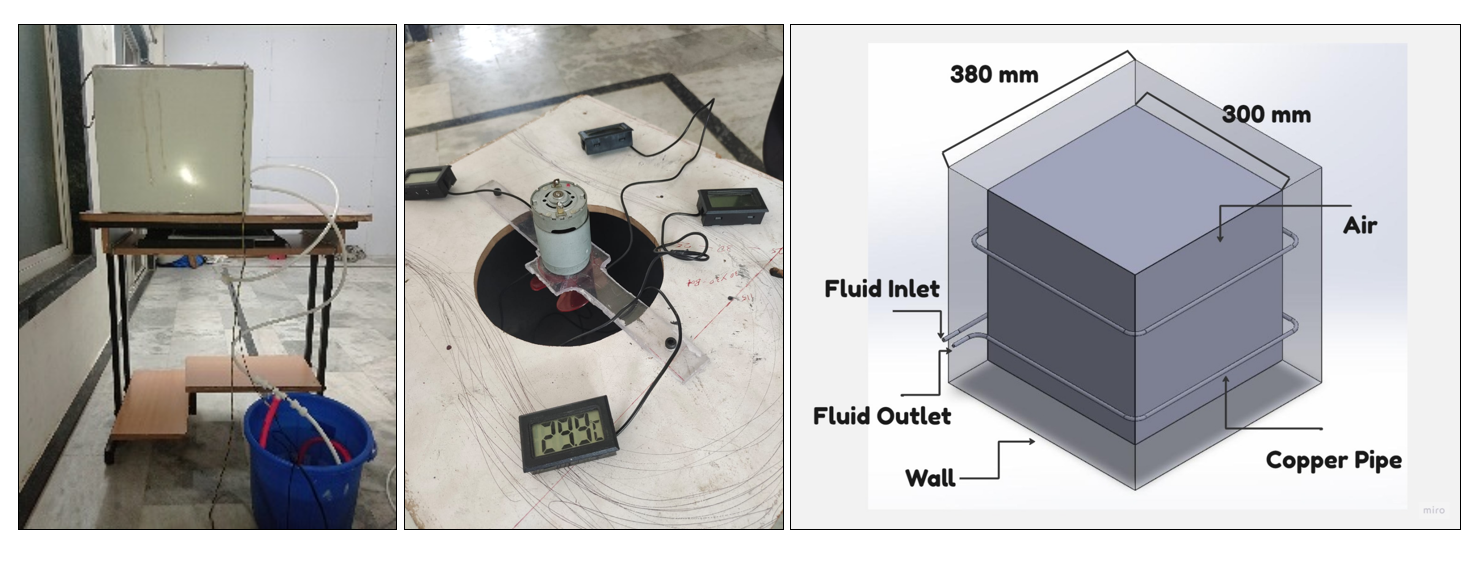
Experimental & CFD Investigation of Radiative Heat Transfer for Room Cooling.
Authors and Affilation
Pranav Lohar, Yash Tajane, Gaurav Dhangar, Mahesh Eshi & Pramod Kothmire
School of Mechanical Engineering, MIT Academy of Engineering, Alandi, Pune
Abstract
In the context of advancing indoor cooling strategies, this research draws inspiration from the potential of radiative heat transfer principles. Historically, studies have highlighted the efficacy of radiant wall heating and cooling technologies, underscored by their compatibility with renewable sources and superior thermal comfort. However, a critical gap remains in effectively enhancing radiative heat transfer by actively cooling room surfaces. To address this, our study introduces an innovative approach: the integration of cooling pipes within walls, enabling the circulation of cold fluid to optimize radiative coolings’ efficiency. Through a comprehensive parametric and comparative analysis, this research elucidates the parameters governing the enhanced cooling process, showcasing its distinct advantages over traditional methods in terms of energy efficiency and thermal comfort. Moreover, Computational Fluid Dynamics (CFD) analysis are performed to comprehensively assess the intricacies of fluid flow and heat exchange within the integrated cooling pipe system. As a result, this investigation contributes to the broader endeavor of sustainable indoor cooling, underscoring the potential of our novel method to revolutionize temperature management and reduce energy consumption in built environments.
Methodology
The methodology employed in our study revolves around the innovative integration of wall-embedded pipes circulating cold fluids to exploit radiative heat transfer for indoor cooling. Through meticulous experimentation and computational modeling, we assess the effectiveness of this approach in achieving efficient temperature reduction. Our methodology emphasizes a comprehensive understanding of radiative cooling principles to pave the way for sustainable and energy-efficient indoor climate control solutions.

Objectives
To investigate and analyze the thermal performance of room cooling systems using two distinct methods. (Radiative Cooling and Forced Convection)
How does the different fluids affects the performance and how does the variation in flow rates influence the temperature dynamics of the system over time in the Radiative Heat Transfer for Room Cooling?
Findings and Conclusion

Radiative cooling potential: The study highlighted the effectiveness of radiative cooling, facilitated by a unique wall-integrated pipe system, as a promising solution for indoor temperature regulation.
Comparison with forced convection cooling: Radiative heat transfer exhibited a notable 20% reduction in cooling time compared to conventional forced convection cooling methods, indicating enhanced energy efficiency.
Advantage of brine solutions: Brine solutions demonstrated significant advantages as cooling agents, with a remarkable 41% reduction in cooling time compared to water. This finding emphasizes the practical benefits of utilizing innovative cooling fluids.
Computational approach and credibility: The integration of computational fluid dynamics (CFD) enhances the study's credibility, showcasing the synergy between theoretical models and real-world applications. This emphasizes the increasing importance of CFD in sustainable energy solutions.
The research contributes to shaping the trajectory of future cooling technologies, aligning with global efforts toward sustainable energy practices. The study's findings have significant implications for improving energy efficiency, reducing environmental impact, and enhancing indoor thermal comfort. The study's practical applicability makes it a valuable addition to sustainable cooling solutions, with potential benefits in lowering energy consumption and minimizing carbon emissions.
Post a comment